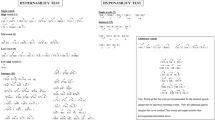Abstract
The objective of the study was to determine the effect of the maxillary sinus on the voice. The prospective study was conducted at an academic secondary referral center. A prospective chart review of 43 patients (17 males, 26 females) who conducted a voice recording and survey before and 3 months after middle meatal antrostomy whose lesion was confined to the maxillary sinus. Subjective voice changes were surveyed using a questionnaire. After phonation [∧m ma: the Korean pronunciation of ‘mother’], [Nu Na: the Korean pronunciation of ‘sister’], we analyzed the nasal consonant [m] of [∧m ma] and nasalized vowel [a] of [∧m ma] and [a] of [Nu Na]. In the poll conducted, the change rates for males and females were 41.1 % (7/17) and 15.4 % (4/26), respectively; of the male patients, 85.7 % (6/7) felt that the sound quality was better and 14.3 % (1/6) that it was worse. However, all the female patients felt it was better. Among of the patients with an improved voice, reduced nasal sound was the most frequent observation. In an objective analysis, a tendency to lowered frequencies was observed for nasalized vowels after surgery. Significant differences were observed at second formant frequencies of [a] of [∧m ma] and first formant frequencies of [a] of [Nu Na] in female subjects (P < 0.005). Our findings indicated that the maxillary sinus plays a role in the modification of voice quality. Preoperative counseling is important for patients concerning expected changes in the voice after maxillary sinus surgery.

Similar content being viewed by others
References
Masuda S (1992) Role of the maxillary sinus as a resonant cavity. J Otolaryngol Jpn 95:71–80
Dang J, Honda K (1994) Morphological and acoustical analysis of the nasal and the paranasal cavities. J Acoust Soc Am 96:2088–2100
Hong KH, Kwon SH, Jung SS (1997) The assessment of nasality with nasometer and sound spectrography in patients with nasal polyposis. Otolaryngol Head Neck Surg 117:343–348
Chen MY, Metson R (1997) Effects of sinus surgery on speech. Arch Otolaryngol Head Neck Surg 123(8):845–852
Fant G (1960) The acoustic theory of speech production. Mouton, The Hague, pp 139–161
Housemann W, Gode U, Dunker JE, Esyholdt U (1998) Influence of endoscopic sinus surgery on voice quality. Eur Arch Otolaryngol 255(10):499–503
Kataoka R, Michi K, Okabe K, Miura T, Yoshida H (1996) Spectral properties and quantitative evaluation of hypernasality in vowels. Cleft Palate-Cranio 33:43–50
Kent RD, Liss J, Philips BJ (1989) Acoustic analysis of velopharyngeal dysfunction in speech. In: Bzoch K (ed) Communicative disorders related to cleft lip and palate. Little-Brown, Boston, pp 258–270
Acknowledgments
This manuscript was presented at the 88th Annual Congress of Korean Society of Otorhinolaryngology-Head and Neck Surgery, Seoul Korea, April 26–28, 2014 and was awarded first place in the part of poster presentation session.
Conflict of interest
The authors have no funding, financial relationships, or conflicts of interest to disclose.
Author information
Authors and Affiliations
Corresponding author
Rights and permissions
About this article
Cite this article
Koo, S.K., Kwon, S.B., Chon, K.M. et al. The role of the maxillary sinus on the voice. Eur Arch Otorhinolaryngol 272, 2347–2350 (2015). https://doi.org/10.1007/s00405-014-3357-z
Received:
Accepted:
Published:
Issue Date:
DOI: https://doi.org/10.1007/s00405-014-3357-z



